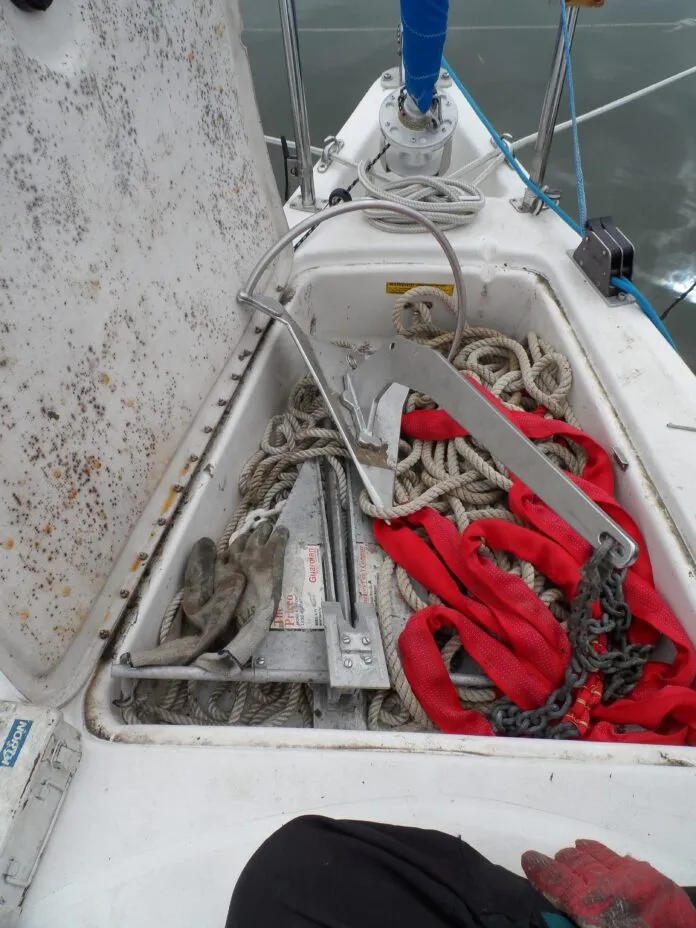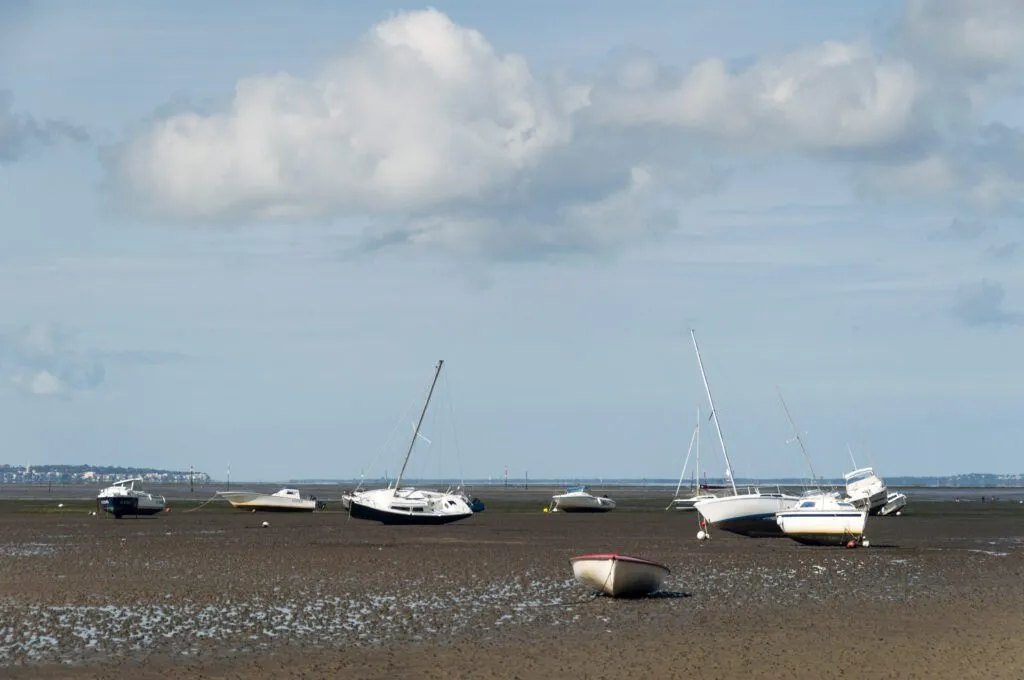
In order to minimize the strain on our anchor, we expect the rode to absorb impact forces imposed by waves, yawing and gusts. These can be as much as five times the average load based on Practical Sailor and ABYC testing. Chain does this through the effect of catenary and resistance to being dragged side to side across the bottom, if the water is deep enough that the mass of chain deployed is enough. Nylon does this by stretching as much as 3 to 4% in length at 10 to 12% of breaking strength, which is the practical working load limit (WLL) if you want a long life. This amounts to 3 to 4 feet if 100 feet are deployed. If less than 100 feet there may not be enough stretch. The polyester single braid recommended for anchoring stretches just less than half as much, about 1 to 2% at 10% of breaking strength. But before we summarily dismiss it as unsuitable, there are several things to consider.
How much stretch do we actually need? In fact, many sailors have proposed and PS testing confirmed that when nylon rode is longer than 150 to 200 feet, or a snubber longer than about 60 to 80 feet (snubber stretch is added to chain catenary), rode tension can actually increase due to increased yawing. The rode stores energy and releases it, something like a rubber band but more slowly. The length at which this occurs depends on the yawing characteristic of the boat. Thus, if more than 150 feet of rode is deployed, something less stretchy may actually be better. One solution is an oversized nylon rode, which is a good choice for smaller boats, since it is easier to haul in without a windlass and is more durable.
WORKING LOAD VERSUS BREAKING STRENGTH
The strength of polyester and nylon are very similar, with a slight difference depending on construction and manufacturer. The working load limit (WLL) of wet nylon depends on the lifespan desired, but is conservatively taken as 12%. Wet polyester has a working load limit of 30%. This is important when the diameter of the rope is limited. For example, when splicing rope to high strength chain (grade 40 and up) the rope has a much lower WLL than the chain. If the chain runs over a combination gypsy it cannot be upsized. Also, boats that anchor in very deep water may have trouble storing a larger diameter rode. Note: 8-strand rope is spliced by tucking, not with a bury splice like Amsteel Dyneema 12-strand single braid.
HEATING DUE TO CYCLICAL LOADING
Polyester is much less prone to heating because it absorbs less energy per unit length. But PS and U.S. Navy testing have confirmed that this is only an issue in ropes larger than ¾-in., and only then if the nylon cycled frequently well above its WLL. This can be the case in docklines, which are short and subject to high frequency cycling in a severe storm, but not for a properly sized rode (see “Overheating Ropes”). The ends of a failed rope are common seen to be melted, but this is nearly always the combined result of external heating caused by rubbing over a chock and the enormous energy released at the moment of rupture (see “Overheating Ropes”). Heating can be important for docklines, but polyester generally has insufficient stretch for this application because docklines are relatively short. On the other hand, the stern lines for our test trimaran are unusually long and we have been testing a recycled polyester dockline (Marlow Blue Ocean) for six years. The stretch has been sufficient, and durability and chafe resistance has been better than the nylon line on the other corner.
Chafe Resistance. Chain is king. But it is also heavy and long lengths can be cumbersome even on larger boats. Polyester rope is about two to four times more chafe resistant than nylon, depending on the specific test. It is also less prone to cutting under high tension. Finally, used as an extension on a chain of more than 150 feet in deep water, the rope rode is not likely to actually be on or near the bottom.
UV Resistance. Polyester is nearly twice as resistant as nylon. Of course, if you mostly anchor at night and don’t secure the nylon rode in exactly the same place every time (most of the rode is underwater or in the locker) this is not a major consideration. For docklines it is important.

Less Stretch Mean Less Movement Over the Roller and Around Chocks. Less movement means less chafe. Chafe gear and locating cleats near chocks and with limited angles is still important.
Nylon Gets Hard. Over time, nylon stiffens, the result of internal wear. In truth, by the time the change becomes obvious, the rope is well past time for retirement, so consider this an indication. Polyester is less prone to this because of its higher WLL and lower stretch.
WHEN DOES POLYESTER MAKE SENSE FOR RODE AND DOCKLINES?
Chain Extensions for Deep Water. When a short length of chain, less than 50 feet, is combined with rope, the rope provides most of the energy absorption and it better be nylon and you must deploy at least 50 feet of nylon to prevent overloading of the nylon. But when rope is used to extend a long chain, say over 200 feet, chain catenary provides more of the energy absorption, and so material strength and high WLL become more important than high stretch. Perhaps the stretch of nylon becomes too much at some point, increasing yawing forces.

Big Tides. The U.K. and the English Channel has a greater tidal range than most of the U.S. I can anchor in five feet of water in the mid-Chesapeake Bay, secure in the knowledge that unless a strong north wind is coming, there will be 3 ½ feet or more at low tide. In Maine and Scotland the tidal range is 15 to 20 feet or even more, meaning I have to anchor in a minimum of 25 feet at high water and calculate my scope on that basis. In the Chesapeake Bay I seldom need more than 100 feet of rode, so my chain extension is nylon. But in the U.K. or Maine I might routinely need 250 feet or more. With that much rode out, whether chain or rope, polyester is stretchy enough.
Big Boats. This is a relative term, of course, but at some point waves and gust have relatively less effect on the boat. A tender in a calm harbor will tug violently at her painter when a small wake passes, while the same wake won’t move the mother ship. Ships use chain without a snubber because small (in proportion to their size) waves and gusts have relatively less effect on them. Thus, for boats over 60 feet the rules gradually change, with strength and chafe resistance becoming relatively more important than stretch. The line, both rode and docklines, will also be longer. The riggers we interviewed suggested that up to ¾-in. they prefer nylon for docklines, but for 1-in. and above they switch to polyester.
Kedging (moving boat using an anchor) and Shorelines. Less stretch is better, even Dyneema. Nylon stretches like a rubber band making it quite unpleasant for the purpose and potentially dangerous (if it breaks the recoil can be a lethal bullwhip). Likewise, shore ties should be low stretch; waves don’t come from that direction and stretch just makes for slack and surge on the other lines.
Never Prestretched Double Braid. Throughout this discussion we have been talking about 8-braid polyester mooring line, not the polyester double braid yacht line available in U.S. chandleries. This is a low-stretch construction suitable for sheets and control lines but not for dock or mooring lines. It has less than half the stretch of polyester 8-strand braid.
Downsizing When Using Polyester to Get more Stretch. Because the WLL of polyester is much higher, it has been suggested you could downsize and get stretch more similar to nylon. However, you give up strength, chafe resistance (more pressure per square inch of surface area) and UV resistance (less strength to start with). We recommend using the same size that is recommended for nylon. Conservative oversizing, on the other hand, is not needed or recommended, in part because of further stretch reduction.
Multihulls and Other Boats That Use Bridle Snubbers. Most multihulls use a nylon bridle to combat yawing and to serve as a snubber when anchored on all-chain. On our PDQ test boat extended the snubber to the mid-ship cleats to give additional length when anchored in shallow water. Between the 100 feet of chain and the 50-ft. bridle length, we really did not need stretch in the rode, and polyester would have several considerable advantages. Better chafe resistance on the bottom and through the combination gypsy. Better wet strength where spliced to G43 chain. Better UV resistance. But this depends on having a long, stretchy bridle (many are too short and over-sized) and at least 100 feet of chain. This is a subset of deepwater chain extensions.
Some monohull sailors use a snubber with nylon rode, not for stretch but to eliminated chafe on the roller (the snubber is short and disposable). This snubber could be polyester—it would wear better, and it does not need to provide shock absorption.
As long as you have shock absorption somewhere, many combinations can work. On our F-24 test boat we use an oversized nylon rode to limit stretch, improve wear, and improve grip when hauling by hand.
Material Relative Density (g/cm3) difference from seawater (g/cm3) Nylon 1.15 +0.13 Polyester 1.23-1.38 +0.20 to +0.35 Seawater 1.03 Freshwater 1.0 Dyneema 0.98 – 0.05 Polypropylene 0.89-0.92 -0.14 to -0.11 Shore lines are nearly always on the surface because of geometry, so mark them with brightly colored buoys if traffic is possible (yellow fish net floats attached with luggage tagged sling).
WHEN DOES POLYESTER NOT MAKE SENSE?
Rodes Smaller Than ⁵/₈ -in. and Most Docklines Smaller Than ¾-in. Shallow water rodes, used in less than 20 feet of water. Never polyester double braid; we tested this in shallow water anchorages, both as rode and as snubber and it was a jackhammer. Same with docklines, even long spring lines. Some folks use retired halyard for docklines, but they either like a rough ride or have a very protected slip.
Practical Sailor’s Best Choice is Samson.
Manufacture Samson Liros Buccaneer Rope Company
Model Tenex 3-Strand Polyester Champion 8
Material polyester polyester Polyester
Construction 8-plait 3-Strand Polyester 8-plait
Strength in pounds (¾-in.) 22400 13400 15800
Price ($/foot) $1.88 2.35 1.65
Combining a nylon snubber with polyester rode has been suggested, in part to increase shock absorption, but also to reduce chafe; the inexpensive snubber carries the load over the roller, reducing wear on the expensive rode. In fact, some people use a polyester snubber or bridle with a nylon rode for this same reason; to reduce wear on the rode at the roller. We’re sure a nylon snubber on polyester rode would work, we’re just not sure it is worth the added fuss. Perhaps for situations that suggest better chafe resistance than nylon can provide, but on boats too small for all-chain rode. Or for boats that normally anchor in deep water, but occasionally anchor in shallow water, where too little polyester rode would be deployed to give adequate shock absorption.
Summary. Nylon will remain king in U.S. waters for most sailors. But for big boats, long chain extensions, and deep water, polyester 8-braid has better specs and is well proven.





































This was a helpful and informative article. You offered lots of technical detail.
But, and maybe I missed it, I didn’t see anything on recommenced service life polyester and nylon. Although service life is mentioned qualitatively, you didn’t say how many years, even as a range.
We bought our boat used so we have no idea about the age of our anchor rhodes. Could you offer some recommended service lives for each material, likely for saltwater and freshwater environments? We are on the Great Lakes but I suspect others would be interested in service life recommendations.
Thanks,
…..Ed
The problem is that rope does not age sitting in a closet at home. I’ve tested 30-year old climbing ropes that still tested like new, both strength and dynamic characteristics. They don’t age much more than that in a locker. Salt matters little, not just sitting. It is all about load cycles, UV exposure, and abrasion.
UV. 3 years is about the limit for nylon in sun, losing about 10% per year (depends on latitude and color). As a dockline it can last longer, if it is over strength. But how much sun does any given section of rode see? It is not exposed in the locker and not underwater, so only a 15′ section from locker to water, and not always the same section. Probably not a big deal unless you live on the hook.
Cycles. Load cycles in fair weather don’t really matter; they are too far below the WWL. Storms on the other hand count a lot, but much depends on exposure and duration. Certainly many, many dozens of strong thunderstorms, a dozen or more sustained storms (nor’easter), and maybe one tropical storm you barely survived. Again, I am speaking about nylon; polyester is about 5 times more fatigue resistant.
Abrasion. External cafe is relatively easy to gauge. Sand and rocks will do more, mud much less. Internals chafe is trickier, but if the rope is much stiffer, that is a clue. Washing or adding certain treatments (water repellents or fabric Softener will limber it up but NOT undo the damage.
The bottom line is that a nylon a rode can last 2-20 years, depending on use. I don’t believe there is any such thing as typical use. Dock lines and halyards are different; we know own much sun they get and we know the tugging is constant.
If the windlass has a combination rope & chain gypsy, then the best anchor rope is the one that fits the gypsy. With a proper rope-chain splice, 8-plait nylon backing up chain is an excellent, practical, and very safe on a combination gypsy. 8-plait nylon does not hockle so easily as 3-strand, has some stretch but not as much as 3-strand, and is much lighter than chain. Notably, 8-plait nylon does not unwind when stretching, and rewind when contracting. This unwind-rewind of our old 3-strand made a mess of snubbers and a lot of clunking noises at night. 150′ of chain + 150′ of 8-plait nylon worked well for us when full-time cruising and anchoring a lot.